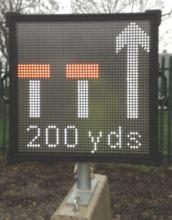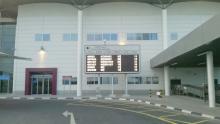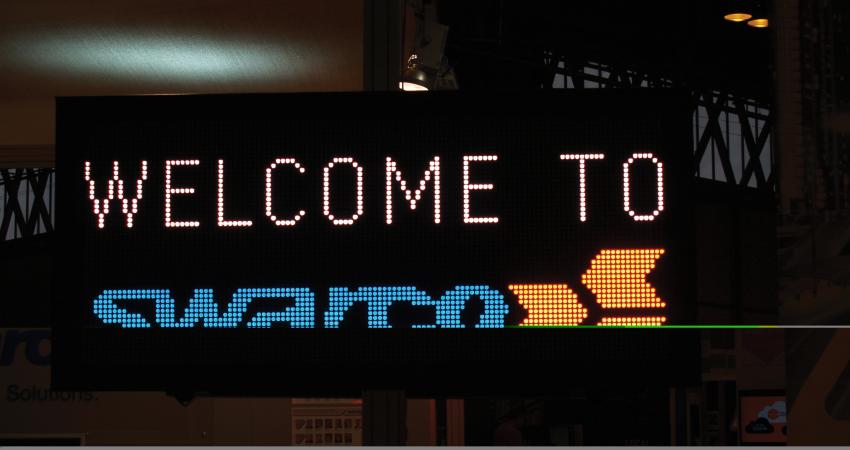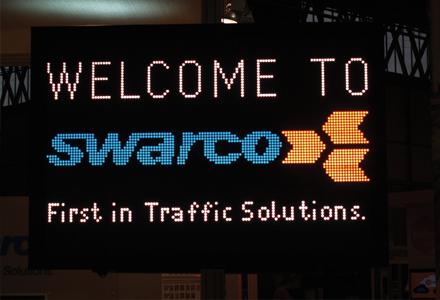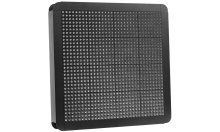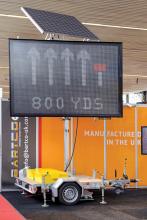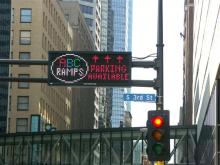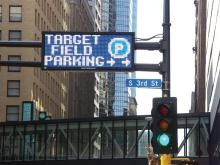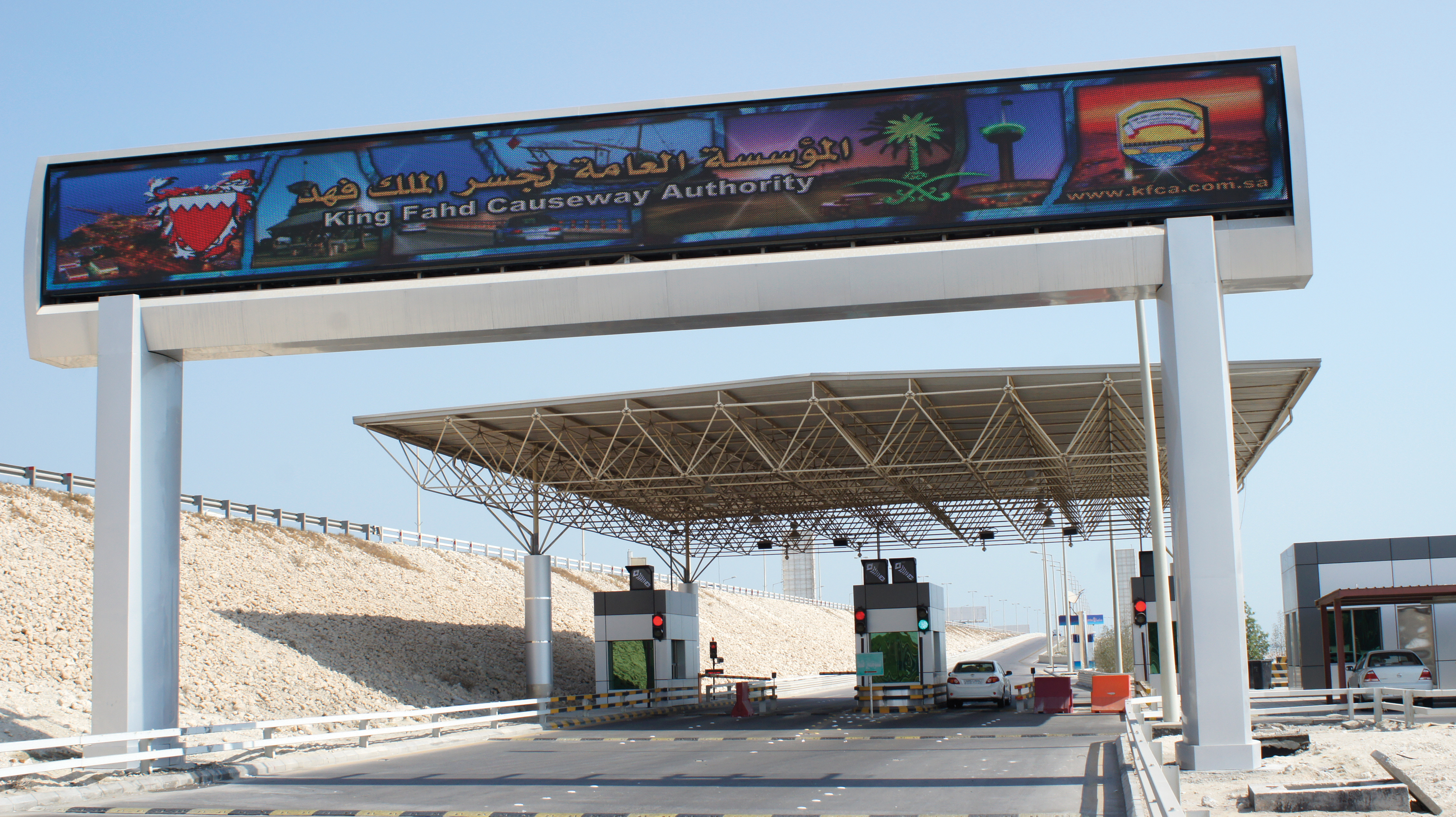
Variable Message Sign systems are helping ease traffic congestion and keeping drivers better informed on key highways across Europe and the rest of the world. Guy Woodford looks at some of their recent applications
By coupling its Intelligent Travel Time System (ITTS) with Bluetooth technology, Alcatel-Lucent is measuring traffic flow in real time and conveying it seamlessly to local authorities in the French city of Vélizy-Villacoublay.The city, a major business enterprise hub 14km south-west of central Paris, is the subject of a six-month pilot of ITTS technology which began in October 2011.
ITTS linked roadside sensors detect the presence of Bluetooth devices embedded in vehicles, such as mobile phones and satellite navigation systems and, using information based on route selections using on-line maps, it can provide information to motorists through road signs, and mobile devices including phones, and through the use of internet sites such as
The ITTS system provides real-time travel time, average speed, alternate route planning, and personalised travel-time predictions. The system can also provide advanced warning of road congestions, and predictions taking into account special events such as sports competitions, accidents, and weather conditions that are annotated in the system by the operators.
For local traffic authorities, congestion information gained from being able to observe traffic patterns throughout the day with ITTS can help improve future planning of road and lane systems.
With its top corporate offices, a large shopping centre, factories and a French military airbase in the area, the roads of Vélizy- Villacoublay are regularly congested at peak hours. With the introduction of ITTS, the City hopes to better manage congestion.
Speaking about the ITTS trial Monique Loison, deputy mayor of Vélizy-Villacoublay, said: "We were keen to test this solution so that we can help our citizens and those who work in our business area, Inovel Parc, to estimate their daily travel times. In this way, all of us can adapt our daily travel schedules and therefore better plan our professional and personal lives."
Pascal Homsy, chief executive of Francebased Alcatel-Lucent, said ITTS was a "costeffective" and "easily deployable" way of boosting road safety.
The ITTS system is also being trialled in Orlando, in the United States. The trial is being seen by many road safety and environmental campaigners as particularly timely due to rising congestion in America's major cities.
In the English West Midlands, a project designed by
The Siemens Elektra signs will provide drivers with a range of messages from events, road works and wide load movements to route diversion and selection, and public transport information. The new signs will be installed on key radial routes including the A34, A53, A525 and A52, and will be linked to Staffordshire County Council's Siemens Comet VMS control system based in Stafford.
Siemens had already provided similar VMS technology near to Stafford Town Centre.
Italian firm
The Al Salam Street Project in Abu Dhabi, UAE, consists of four construction contracts for grade-separated interchanges, tunnels, road widening and other improvements.
Solari's new full colour and graphic monochromatic lane control and speed limit VMS system is being installed as part of the works transforming the existing Al Salam Street alignment into an uninterrupted traffic corridor.
In the Netherlands, hundreds of the company's large full graphic, colour and bi-colour (red and white) VMS have been supplied for use on the A12, and the A13/A29 in Rotterdam. It's also being used on highways in Middleburg, Den Haag, Westland, and Enschede.
Conforming to European regulation EN 12966, Solari's new VMS is said to offer maximum flexibility in its texts and images.
The firm claims this flexibility makes it easy to manage any kind of language and characteristics from European to Arabic, Indian or Asiatic languages.
The Solari VMS, and their often accompanying Lane and Speed Control Signs (LSCS) system, are being used not only for highway and arterial road management as part of an Advanced Traffic Management System, but also to aid tunnel management.
Conscious of potential environmental impact, Solari's VMS is manufactured with recyclable materials using eco-friendly production techniques. They are said by the firm, based in Udine, north-east Italy, to be high efficiency LEDs with special optical solutions that use minimum power consumption and, therefore, emit less CO2.
Solari's NTCIP standard software is used in its new traffic control system which integrates what is said to be an easy to use GUI (Graphical User Interface) based on a GIS (Geographic Information System) where it is possible to manage not only VMS and LSCS but also other devices such as cameras, traffic detectors and weather stations. The new traffic control system can also be used to manage major events.
Each Solari VMS can be equipped with a Bluetooth antenna that can transfer to drivers' mobile phones information about the traffic conditions on the highway and surrounding areas. At the same time, another Bluetooth antenna can detect information about the traffic flow by listening to the numerous Bluetooth devices installed in the cars, providing relevant information to a traffic management centre. This can be a cost-effective way of evaluating travel time information that is often displayed on VMS.
The VMS from Solari can also be equipped with traffic detectors able to give very accurate information about vehicles concerning their class, speed, length, and height, the distance between vehicles and queue details including waiting times. They can also provide potentially vital automatic detection of highway incidents.
US-based
First introduced in 2009, the VMS has been said by city government parking system analyst, Greg Stumpf, to have noticeably reduced tragic congestion around landmark venues such as the Minnesota Twins' Target Field baseball park, the Minneapolis Convention Centre and the Downtown Theatre District.
"So far, the plan has worked well as we have strategically placed these signs throughout downtown," said Stumpf.
"We need to be able to change these messages in a snap, and the Vanguard software allows us to display customised messages very quickly.
"By referencing the MUTCD (Manual on Uniform Traffic Control Devices), we can use the Daktronics control software to create and display our messages on any combination of sigs around downtown." Wi-Fi technology connects several of the VL-3500 model VMS to their control system which, according to Stumpf, saves times and money for the City's transport department.
Quick, reliable connectivity has proved especially important for use of VMS around Target Field, which regularly brings in up to 40,000 people to the downtown area in a matter of hours.
Daktronics HD12 LED video displays sold by partners PKE Gulf WLL and installed last year on the King Fahed causeway, a 25km bridge that connects Saudi Arabia to Bahrain, are helping King Fahed Causeway Authority (KFCA) convey general traffic and safety information to causeway users.
Of the five displays, three are located on the Saudi Arabia side and two are located on the Bahrain side. All signs are visible to traffic entering the causeway from both sides.
Daktronics and partner PKE Gulf WLL hosted a delegation from the KFCA for additional technical training following the installation of the technology.
Orders in Scandinavia included the installation of 17 of the company's DRIPs (Dynamic Road Information Panels) for roads in the Norwegian capital of Oslo. In Sweden, four DRIPs were installed in the southern province of Skåne on the E22S north of Malmö. A further DRIP was fitted at Stockholm's Kungens Kurva, and another in Björkliden in northern Sweden.
Meanwhile, in Swarco Futurit's native Austria, 16 of its VMS tunnel signs were fitted at the A11 Karawankentunnel in Austria. Two VMS information signs were also placed at the tunnel's entrance.
Since the early 1990s, Swarco Futurit has focused on designing lens technology that allows LEDs to be driven at lower power without any loss of optical performance.
The quality of VMS is reflected, to a large extent, by their optical performance efficiency (OPE). Swarco Futurit says it emphasises OPE in its VMS, which meet EN 12966 requirements that its optical performance parameters are met for at least ten years. Lifetime and stability of optical performance being parameters of reliability are mainly depending on the current load of the LED, the relation between the operating current and the maximum allowed current. Swarco Futurit claims its takes the lead in this field, knowing from its experience in the past 15 years that if the current load does not exceed 15%, no degradation can be expected for the technical life of the VMS.
OPE can be calculated by means of the formula OPE = LR x IN x BW x pp² / a x 1² x Lx, taking into account luminance ratio, maximum allowed forward current, beam width acc.
EN12966-1, pixel pitch, the number of light sources per element, the operating current necessary to meet luminance and luminance ratio, and a factor depending on the achieved luminance class as specified in EN12966-1.
Optical performance efficiency of Swarco Futurit VMS and DRIPs mounted above or next to highways is 318 (white), 263 (yellow), 1,143 (green), 231 (red), and 429 (blue). Numbers are calculated for a freely programmable graphical display, RGB, 20mm pixel pitch, with photometric parameters class L3, class R3, class B6, and class C2 as specified in EN 12966.
Depending on the application, the German firm's typical LED pixel pitches range from 16mm to 20mm thereby offering superior legibility of the VMS sand wider viewing angle by up to 30°. Nissen claims this is far superior to any other system on the market.
Featuring Nissen's patented technology anti-glare screen and sea-water resistant aluminium housing, the VMS is said to be ideal for all weather conditions.
This new range of VMS is said by Nissen to be being supplied to many European countries as well as Australasia, where the systems are claimed by the company to be improving road safety and increasing information for drivers.
Most of the Nissen VMS systems supplied within Europe to date have been trailer mounted with up to three VMS screens. The majority ordered have been single or double VMS.
The 4-colour VMS vary in size, colour and control mechanisms. Nissen says the system speci cations are often based on customer wish lists combined with regional and national legislative requirements.
All VMS systems comply with the European and British Standard BS EN 12966.
Over the past six months, Nissen has supplied its VMS systems for applications ranging from centre reserve signs (MultiSign) to vehicle tted systems. The centre reserve systems are operated using a Bluetooth remote control which enables the operative to set speci c parameters and symbols while a radio remote is used for simple on/off activation of the signs.
The VMS are equipped with Red/White LEDs to display Arrows, Red Cross and various lane closure (wicket) signs. The systems are tted to Incident Support Units (ISUs) which allows Traf c Management Operatives (TMOs) to arrive at the incident or works site and switch on the appropriate sign from cab- tted remote control. Nissen says its VMS is highly legible over a long distance to ensure it attracts motorists' attention in order for them to change their driving accordingly.
Additionally, Nissen has supplied its VMS systems for sweeper vehicles as well as small vans. The systems are either tted on the roof rack or on back of the sweeper vehicles to warn motorists of roadworks, incidents and/or routine maintenance.
In every case, the operatives are very pleased with the performance, reliability and ease of use of these systems.
As the European countries and Australasian countries tend to use the trailer-mount VMS systems, Nissen VMS is supplied with Bluetooth remote control and the Nissen Navigation System (NiNa): bespoke software to operate the signs using the internet from any location.
Greek firm Top Vision recently installed its VMS technology in central Athens. The project, on behalf of Siemens and the Tra- c Control Management Centre of Athens, included VMS with mounting structure, management software and a human friendly interface that can interact simply with the existing Tra- c Control Management Centre (TCMC) system.
The new VMS and TCMC link-up provides drivers with information on real-time tra- c conditions to help them get to and around all the key destinations of the Greek capital.
The VMS tted by Top Vision is described by the company as full matrix and has all required certi cations. Top Vision is also certi ed by ISO 9001:2008.
By supplying the VMS in Athens, Top Vision says it has completed a further step in implementing its plan to expand road safety based work.

